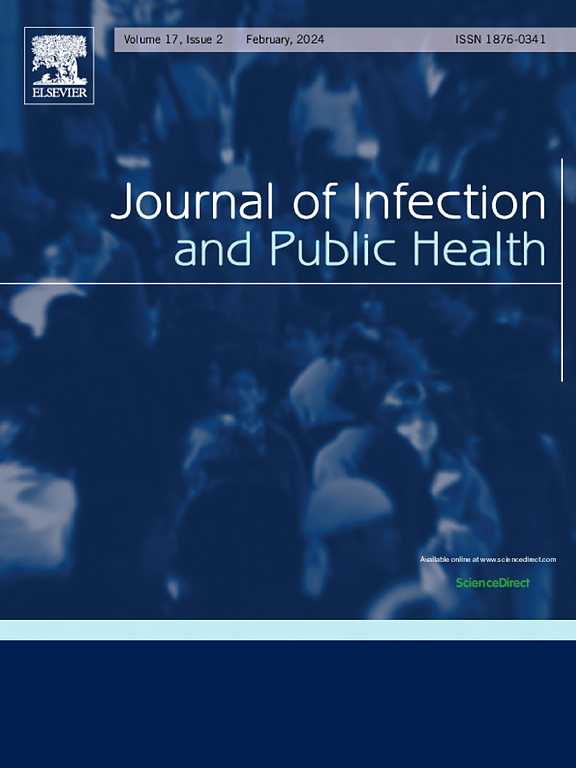Acute hemorrhagic conjunctivitis outbreaks associated with Coxsackievirus A-24 in India, 2023
IF 4.7
3区 医学
Q1 INFECTIOUS DISEASES
引用次数: 0
Abstract
Objective
Acute hemorrhagic conjunctivitis (AHC), commonly called pink eye, saw an alarming increase in incidence from July to September 2023 in different parts of India. Pink eye occurrences had reportedly increased three to four times more than in prior years, raising concerns among the community and healthcare professionals. This study aimed to identify the aetiological agent associated with AHC in 2023, genetically characterize the agent and describe the clinical presentation.
Methods
From July to September 2023, 300 ocular and throat swab samples were collected from patients with AHC across various regions of India, including Maharashtra, Daman & Diu, Delhi, Lucknow, and Hyderabad. These samples represented a diverse geographic spread of the condition. The swabs were examined for qRT-PCR analyses, to detect adenovirus and enterovirus. Following this, conserved regions within the enteroviral 5′-UTR and VP2/3 C gene were further investigated for serotype identification.
Results
Enterovirus was found in 52.6 % (158 out of 300) of the patients. Among the enterovirus-positive samples, coxsackievirus-A24 was present in every positive sample.
Conclusion
The rise in AHC cases in India in 2023 was attributed to the Coxsackievirus-A24 strain GIV C5.
2023年印度与柯萨奇病毒A-24相关的急性出血性结膜炎暴发
目的:从2023年7月到9月,印度不同地区的急性出血性结膜炎(AHC),俗称红眼,发病率惊人地增加。据报道,红眼病的发病率比前几年增加了三到四倍,引起了社区和保健专业人员的关注。本研究旨在确定2023年与AHC相关的病原学因子,对该因子进行遗传表征并描述其临床表现。方法:从2023年7月至9月,从印度马哈拉施特拉邦、达曼和迪乌、德里、勒克瑙和海得拉巴等不同地区的AHC患者中收集了300份眼和咽拭子样本。这些样本代表了这种情况的不同地理分布。对拭子进行qRT-PCR分析,检测腺病毒和肠病毒。随后,进一步研究肠病毒5'-UTR和VP2/3 C基因的保守区域进行血清型鉴定。结果:300例患者中有158例(52.6% %)检出肠道病毒。在肠病毒阳性样本中,每个阳性样本中都存在柯萨奇病毒a24。结论:2023年印度AHC病例的增加归因于柯萨奇病毒- a24株GIV C5。
本文章由计算机程序翻译,如有差异,请以英文原文为准。
求助全文
约1分钟内获得全文
求助全文
来源期刊

Journal of Infection and Public Health
PUBLIC, ENVIRONMENTAL & OCCUPATIONAL HEALTH -INFECTIOUS DISEASES
CiteScore
13.10
自引率
1.50%
发文量
203
审稿时长
96 days
期刊介绍:
The Journal of Infection and Public Health, first official journal of the Saudi Arabian Ministry of National Guard Health Affairs, King Saud Bin Abdulaziz University for Health Sciences and the Saudi Association for Public Health, aims to be the foremost scientific, peer-reviewed journal encompassing infection prevention and control, microbiology, infectious diseases, public health and the application of healthcare epidemiology to the evaluation of health outcomes. The point of view of the journal is that infection and public health are closely intertwined and that advances in one area will have positive consequences on the other.
The journal will be useful to all health professionals who are partners in the management of patients with communicable diseases, keeping them up to date. The journal is proud to have an international and diverse editorial board that will assist and facilitate the publication of articles that reflect a global view on infection control and public health, as well as emphasizing our focus on supporting the needs of public health practitioners.
It is our aim to improve healthcare by reducing risk of infection and related adverse outcomes by critical review, selection, and dissemination of new and relevant information in the field of infection control, public health and infectious diseases in all healthcare settings and the community.
 求助内容:
求助内容: 应助结果提醒方式:
应助结果提醒方式:


